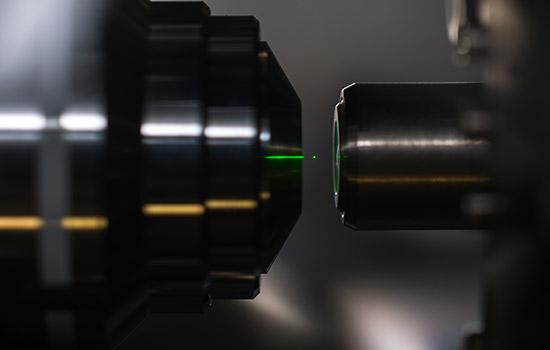A study led by researchers at the Rochester Institute of Technology (RIT), and supported by the U.S. Navy's Office of Naval Research (ONR), will employ the emerging field of levitated optomechanics to investigate precision quantum sensing technologies. Laser trapping techniques and quantum mechanics will be used to test the limits of quantum effects on nanoparticles in isolation.

Levitated optomechanics can make a nanoparticle float in space. A finely focused laser beam forms an “optical tweezer” and creates a tiny, isolated laboratory for the study of delicate quantum states. Courtesy of J. Adam Fenster and Prof. A. N. Vamivakas/University of Rochester.
“Levitated optomechanical systems provide a clean platform for studying
quantum optics, information science, and precision measurement and
sensing,” said Mishkat Bhattacharya, an associate professor at RIT.
To explore different nanosystems, Bhattacharya isolated a nanodiamond in
a pocket of light, suspending the particle in the laser light and
effectively turning it into a floating probe. Bhattacharya is
investigating the signatures carried in the light and the information it
could reveal about the electromagnetic fields and the gravitational
forces surrounding the nanoparticle.
The three-year study is supported by a $550,000 grant and is a
continuation of a previous award. In the first study for ONR, the
research team determined the smallest force that could be detected with a
diamond crystal that levitated without spinning. The new study will
explore the outcomes of three nanosystems, each using nanoparticles
optically trapped under the following different conditions:
1. A particle containing an impurity which acts as a spin sensitive
to magnetic fields or as an excess charge sensitive to electric fields;
2. A particle moving like a pendulum in three dimensions;
3. A particle larger than the wavelength of light entrapping it.
By exploring the interactions between light and tiny particles within the nano-realm, researchers hope to define a way to achieve more precise data capture within a cheaper, lighter sensor design. Sensing technology at the submicroscopic scale promises finer measurements of the physical properties that describe the world, such as electric and magnetic fields, temperature, force, velocity, acceleration and gravitation.
According to Bhattacharya, quantum sensors could someday detect gravitational waves, find dark matter and perfect quantum computing.